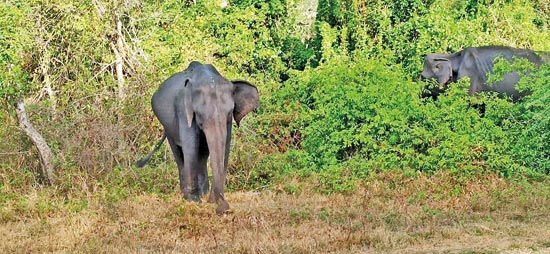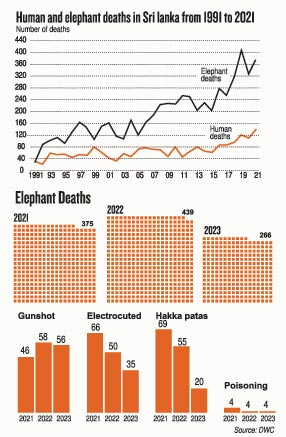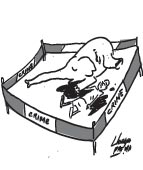News
Wildlife experts urge rollout of delayed plan to ease human-elephant conflict

“If humans had limited access to food and water and their movement was restricted, they would rebel; this is what the elephants are doing,” said Prabash Karunatilake, president of the Collective of Wildlife Officers.
Sri Lanka had recorded 266 elephant deaths as of August 11, 2023. Of this, the Anuradhapura wildlife region reported 53 deaths, while the Eastern and Polonnaruwa regions had 52 and 51 deaths, respectively. At present, these areas have the highest number of elephant deaths in Sri Lanka.
The human-elephant conflict (HEC) has been a prolonged issue that has put both the human and elephant populations at risk.
In August 2020, former president Gotabaya Rajapaksa appointed a committee, headed by Dr. Prithiviraj Fernando, an eminent elephant expert, to formulate a national action plan for the mitigation of the HEC. The committee consisted of public and private stakeholders, including the Department of Wildlife Conservation (DWC). The plan was presented to the then-president in December 2020, but it was ignored until recently.
President Ranil Wickremesinghe appointed a presidential committee to facilitate and oversee the implementation of the plan in October 2022. However, implementation has been slow.
During the plan’s preparation, it was found that during 2010–2019, Sri Lanka had the highest number of annual elephant deaths and the second-highest number of human deaths due to the HEC.
The plan consists of short-, medium-, and long-term recommendations and emphasises joint efforts. It has also called for decentralised roles and responsibilities among various stakeholders.
The plan includes the building of community-based electric fences, the continuation and strengthening of compensation for deaths, injuries, and property damage, insurance initiatives, the installation of street lighting in critical locations, and conducting awareness programmes, to name a few.
It also calls for the minimisation or discontinuation of activities such as elephant drives that may increase conflict. The plan further proposed that a presidential task force be established to monitor implementation and conduct an annual review and revision.
 “The implementation of the National Action Plan has been extremely slow and is seen only in some areas like Anuradhapura and Kurunegala,” noted Panchali Panapitiya, founding director of RARE.
“The implementation of the National Action Plan has been extremely slow and is seen only in some areas like Anuradhapura and Kurunegala,” noted Panchali Panapitiya, founding director of RARE.
“If we can implement it as a whole, we will be able to minimise the human-elephant conflict significantly. The short-, medium-, and long-term recommendations can convert the conflict to coexistence,” said Supun Lahiru, an environmental activist and researcher.
He emphasised the importance of decentralising roles and responsibilities, drawing attention to the fact that it is impossible for a single department with limited resources and staff to bear all the responsibilities of HEC mitigation. According to him, more than 20 rangers had lost their lives.
“There is a scarcity of rangers as there are more than 50% vacancies,” Mr. Karunatilake said.
This scarcity has led to fewer officers being deployed to high-risk sites, ultimately putting their lives in danger.
According to Mr. Karunatilake, finding and implementing sustainable solutions are of vital importance. “We need to ensure that elephants have habitats and that the development programmes and lives of animals and humans are not wasted.”
The DWC has been taking the usual measures, which include, but are not limited to, installing and repairing electric fences, installing streetlights, and conducting awareness programmes in coordination with Grama Sevakas and Pradeshiya Sabhas.
However, they have also been facing issues in terms of illegal electrical lines drawn up by residents in areas where elephants and residents have damaged the electrical fences installed by the DWC. The illegally drawn electrical lines have resulted in the deaths of elephants by electrocution. Legal action has been instituted against these property owners.
“We are trying really hard to protect both humans and elephants, and we need the support of the residents for this,” remarked an official from the DWC. The department is also in the process of acquiring areas overlapping elephant corridors. There have been 16 elephant corridors identified, many of which contain human settlements and development projects. As such, the DWC is presently providing compensation to those whose settlements were in the corridors and were required to relocate.
Meanwhile, the adverse weather conditions are also affecting the elephants. The watering holes they use are being filled with water by the DWC. Additionally, the DWC official confirmed that there is a higher threat of poaching owing to the drought conditions, as people will most likely hunt animals that come to watering holes.
The official reaffirmed that legal action would be taken against poachers under the Flora and Fauna Ordinance. Moreover, ‘hakka patas’ also continue to be a significant threat to elephants.
“The human-elephant problem is not just environmental; it is also political,” noted Jehan Canagaretna, the president of the Wildlife and Nature Protection Society (WNPS).
He reiterated that the propositions of the National Action Plan, if implemented, would be extremely significant in creating human-elephant coexistence. However, Mr. Canagaretna noted that, simultaneously, measures should also be taken to change the mindset and attitudes regarding elephants.
He said elephants are attacked and killed because farmers see them as dangerous creatures that pose a threat to their livelihoods and their homes. This is a result of the encroachment and deforestation of their natural habitats. However, for the change of perception to be successful, educators and stakeholders need to be sensitive to the plight of the people.
According to Mr. Canagaretna, 44% of the land is shared by both elephants and people. “Drastic measures need to be taken if we are to have a situation of coexistence between elephants and humans.”
Mr. Lahiru said, “Sri Lanka could convert this conflict into coexistence if the appropriate solutions are implemented.” He also said the support of both the government and the public is vital “to create sustainable habitats and a future for both elephants and people’’.
 At a media briefing held on July 19, Wildlife and Forest Resources Conservation Minister Pavithra Wanniarachchi outlined a new policy.
At a media briefing held on July 19, Wildlife and Forest Resources Conservation Minister Pavithra Wanniarachchi outlined a new policy.
When inquired about this policy, Ms. Panapitiya remarked that successive ministers and governments keep introducing new policies without effectively implementing already existing comprehensive policies. She added that new policies were required for elephant conservation, not HEC mitigation.
Multiple attempts were made by the Sunday Times to contact ministry officials regarding the new policy but to no avail.
The best way to say that you found the home of your dreams is by finding it on Hitad.lk. We have listings for apartments for sale or rent in Sri Lanka, no matter what locale you're looking for! Whether you live in Colombo, Galle, Kandy, Matara, Jaffna and more - we've got them all!

